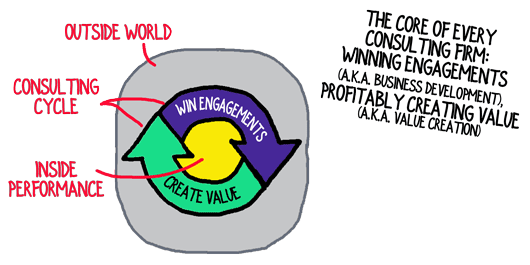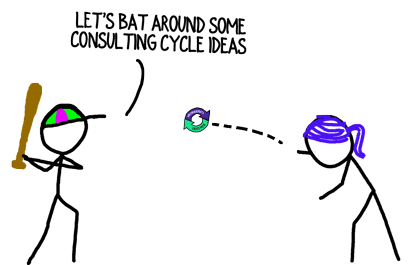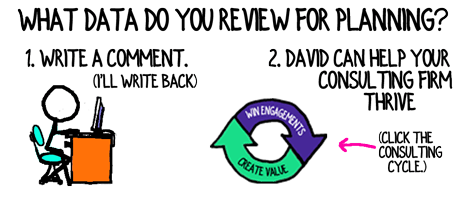You learned about an 8-week alternative to the traditional, gather-everyone-in-a-room-for-two-days approach to annual planning for your consulting firm. (It was in this article.)
Since publishing that piece, consulting firm leaders have lobbed in an array of queries:
- Is the process iterative?
- Who should be involved?
- If we don’t meet for two days, do I still have to share the cheesecake?
The most common question consultants asked about the process was this:
What data should your consulting firm consider during Steps 1 & 2, when you’re examining the facts and gleaning critical lessons that can shape your year ahead?
Good question!
Think of your data review from a few orientations:
Outside, Inside and the Consulting Cycle.
Outside describes the trends, shifts and pressures the external world exerts on your consulting firm.
Inside includes the facts, metrics and information that characterize your consulting firm’s performance.
The Consulting Cycle neatly bridges the Inside performance of your consulting firm, and the Outside world.

Below are some suggestions for facts and data you may want to review in each area:
Outside
Data about the outside world includes any major trends, shifts or news that you believe could alter your consulting firm’s ideal trajectory. Some common places to look are:
- Regulatory
- Industry
- Economic
- Social
- Legal
- Technology
- Competitive Set
Inside
Data about your consulting firm’s inside world tends to focus on your financial performance and results. You’ll gain insights about consulting clients or service lines you should let go, and where you should tweak your consulting firm’s efforts based on profitability.
Common Inside data include:
- Income Statement
- Balance Sheet
- Cash Flow Report by Month
- Revenue and Margin by Service Line
- Revenue and Margin by Client
Value Creation
The Value Creation side of your consulting firm’s Consulting Cycle includes all the tasks, efforts, systems and processes you employ to profitably delight your clients.
At a minimum, your data review should include:
- Unsolicited Client Feedback
- Client Feedback from Surveys
- Delivery Capacity Projections
- Delivery Skill Capabilities and Gaps
- Delivery Performance by Consultant
Business Development
The Business Development component of your consulting firm’s Consulting Cycle covers the gamut of activities that secure revenue from new and existing clients.
For instance:
- Summary of Learnings from Wins (Post Mortems)
- Summary of Learnings from Losses (Post Mortems)
- Feedback on Business Development Process from Prospects
- Network Core Size and Growth
- Visibility Building Successes and Failures
- Business Development Performance by Consultant
What other facts, metrics or information do you look at when evaluating your consulting firm and planning your future?
Text and images are © 2024 David A. Fields, all rights reserved.

 David A. Fields Consulting Group
David A. Fields Consulting Group 


For me, it’s having a more relevant online footprint.
Even though I’m currently strategizing a re-boot for 5/2020, what I’ve learned from all these years of hitting more valleys than peaks is to focus more on obtaining relevant publicity. Without it, it has proven difficult to get as close to my target market’s space as possible (E.g., Vistage, executive learning platforms/spaces).
Years of networking weren’t a total waste of time, but having a Byline under Entrepreneur, Fast Company, etc could’ve made a difference. I begin training for writing such pubs in December. I’m excited for what the future holds.
More content to digest, but thanks so much for such valuable content, David!
Data on your visibility-building plan and what’s worked is a great addition to the list, Lacey.
Different consulting firms will have different experiences with the effectiveness of publicity; however, for every firm it’s worth paying attention to where your clients came from. What has driven your past opportunities to appear?
Thanks for your thoughtful contribution, Lacey.
Besides chocolate, I truly crave your insights as I build my company.
Thank you for this reminder today to constantly apply my ‘consultant’s eye’s to my own business.
I’m writing more and more and will look forward to watching your brilliant work as it shows up in even more prominent places!
You are a treasure. Now about that chocolate…
Laurie
Awww, you’re very sweet… or the chocolate is sweet. Something is sweet!
Anyway, you’re wise to point out that as consultants, we rarely apply our well-developed capabilities (a.k.a mad skizzles) to our own businesses. Part of that is simply because it’s nigh-on impossible to take on a truly dispassionate assessment of our own business. Part, of course, is that consultants aren’t trained to evaluate consulting businesses. But that’s what this content is for!
I appreciate the kinds words and comment, Laurie.